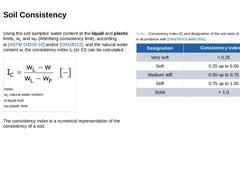
|

Using the soil samples' water content at the liquid and plastic limits, wL and wP (Atterberg consistency limit), according to [[ASTM D4318-10]] and/or [DIN18122], and the natural water content w, the consistency index IC (or CI) can be calculated : (Formula: Consistency index) The consistency index is a numerical representation of the consistency of a soil. (Table: Consistency index IC and designation of the soil state of cohesive soils in accordance … |
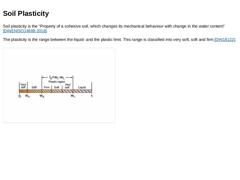
|

Soil plasticity is the “Property of a cohesive soil, which changes its mechanical behaviour with change in the water content” [DINENISO14688:2018]. The plasticity is the range between the liquid- and the plastic limit. This range is classified into very soft, soft and firm [DIN18122]. (Image: Consistency band [Trian00]) |
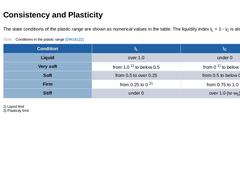
|

The state conditions of the plastic range are shown as numerical values in the table. The liquidity index IL = 1 - IC is also listed. (Table: Conditions in the plastic range [DIN18122]) |
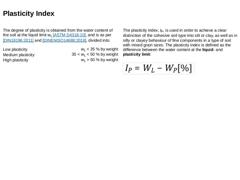
|

The degree of plasticity is obtained from the water content of the soil at the liquid limit wL [[ASTM D4318-10]], and is as per [DIN18196:2011] and [DINENISO14688:2018], divided into: |
Low plasticity |
wL < 35 % by weight |
|
Medium plasticity |
35 < wL < 50 % by weight |
|
High plasticity |
wL > 50 % by weight |
The plasticity index, IP, is used in order to achieve a clear distinction of the cohesive soil type into silt or clay, as well as in silty or clayey … |
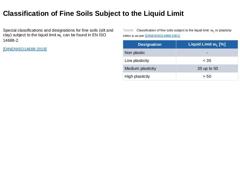
|

Special classifications and designations for fine soils (silt and clay) subject to the liquid limit wL can be found in EN ISO 14688-2. [DINENISO14688:2018] (Table: Classification of fine soils subject to the liquid limit wL or plasticity index IP as per EN ISO 14688-2) |
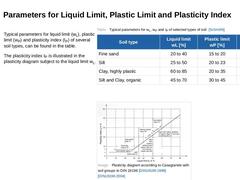
|

|
Typical parameters for liquid limit (wL), plastic limit (wP) and plasticity index (IP) of several soil types, can be found in the table. The plasticity index IP is illustrated in the plasticity diagram subject to the liquid limit wL. |
(Table: Typical parameters for wL, wP and IP of selected types of soil) (Image: Plasticity diagram according to Casagrande with soil groups to DIN 18196) |
|
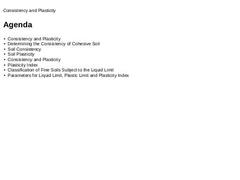
|

|
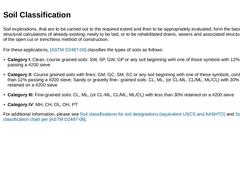
|

Soil explorations, that are to be carried out to the required extent and then to be appropriately evaluated, form the basis for the structural calculations of already existing, newly to be laid, or to be rehabilitated drains, sewers and associated structures by means of the open cut or trenchless method of construction.
For these applications, [[ASTM D2487-06]] classifies the types of soils as follows: |
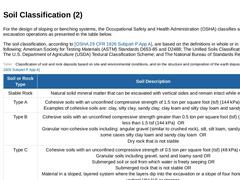
|

For the design of sloping or benching systems, the Occupational Safety and Health Administration (OSHA) classifies soils from excavation operations as presented in the table below. The soil classification, according to [[OSHA 29 CFR 1926 Subpart P App A]], are based on the definitions in whole or in part, the following; American Society for Testing Materials (ASTM) Standards D653-85 and D2488; The Unified Soils Classification System; The U.S. Department … |
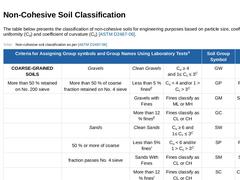
|

The table below presents the classification of non-cohesive soils for engineering purposes based on particle size, coefficient of uniformity (Cu) and coefficient of curvature (Cc) [[ASTM D2487-06]]. (Table: Non-cohesive soil classification as per ASTM D2487) |
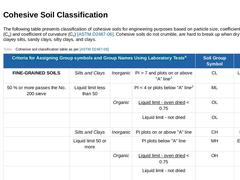
|

The following table presents classification of cohesive soils for engineering purposes based on particle size, coefficient of uniformity (Cu) and coefficient of curvature (Cc) [[ASTM D2487-06]]. Cohesive soils do not crumble, are hard to break up when dry and include clayey silts, sandy clays, silty clays, and clays. (Table: Cohesive soil classification as per ASTM D2487) |
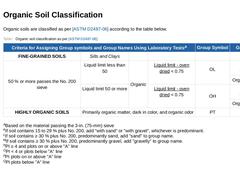
|

Organic soils are classified as per [[ASTM D2487-06]] according to the table below. (Table: Organic soil classification as per ASTM D2487) |
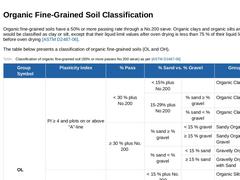
|

Organic fine-grained soils have a 50% or more passing rate through a No.200 sieve. Organic clays and organic silts are soils that would be classified as clay or silt, except that their liquid limit values after oven drying is less than 75 % of their liquid limit value before oven drying [[ASTM D2487-06]]. The table below presents a classification of organic fine-grained soils (OL and OH). (Table: Classification of organic fine-grained soil (50% or … |
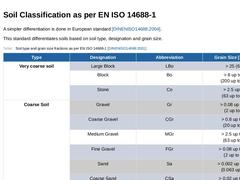
|

A simpler differentiation is done in European standard [DINENISO14688:2004]. This standard differentiates soils based on soil type, designation and grain size. (Table: Soil type and grain size fractions as per EN ISO 14688-1) |
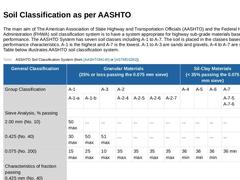
|

The main aim of The American Association of State Highway and Transportation Officials (AASHTO) and the Federal Highway Administration (FHWA) soil classification system is to have a system appropriate for highway sub-grade materials based on their performance. The AASHTO System has seven soil classes including A-1 to A-7. The soil is placed in the classes based on performance characteristics. A-1 is the highest and A-7 is the lowest. A-1 to A-3 are … |
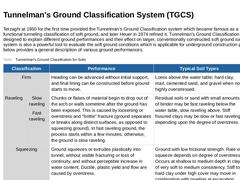
|

Terzaghi at 1950 for the first time provided the Tunnelman’s Ground Classification system which became famous as a common and functional tunneling classification of soft ground, and later Heuer in 1974 refined it. Tunnelman’s Ground Classification System was designed to explain different ground performances and their effect on larger, conventionally constructed soft ground tunnels. This system is also a powerful tool to evaluate the soft ground conditions … |
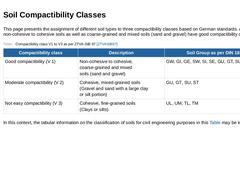
|

This page presents the assignment of different soil types to three compactibility classes based on German standards. As per ASTM, non-cohesive to cohesive soils as well as coarse-grained and mixed soils (sand and gravel) have good compactibility characteristics. (Table: Compactibility class V1 to V3 as per ZTVA-StB 97) In this context, the tabular information on the classification of soils for civil engineering purposes in this (→ Table: Soil classification … |
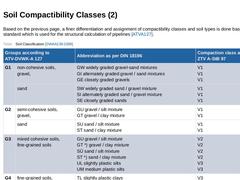
|

Based on the previous page, a finer differentiation and assignment of compactibility classes and soil types is done based on German standard which is used for the structural calculation of pipelines [ATVA127]. (Table: Soil Classification (DWA-A 139)) Further soil characteristics according to EAU 1996 can be found in the following (→ Table: Soil characteristics draft (e 9) of EAU 1996) |
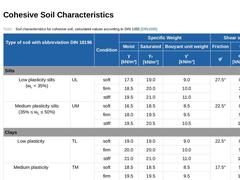
|

(Table: Soil characteristics for cohesive soil, calculated values according to DIN 1055) |

|

The greater the proportion of clay minerals capable of swelling in the particle fraction, the greater is the water-binding capacity and thus also the plasticity of a soil [Lang90]. Clay minerals either developß by chemical alteration of minerals or by new formation in the sedimentation stage and swell depending on the water content. (Image: Influencing variables of the soil - Particle size of clay minerals) (Image: Structure of a … |
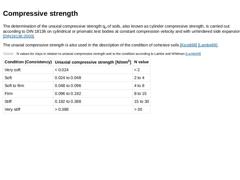
|

The determination of the unaxial compressive strength qu of soils, also known as cylinder compressive strength, is carried out according to DIN 18136 on cylindrical or prismatic test bodies at constant compression velocity and with unhindered side expansion [DIN18136:2003]. The unaxial compressive strength is also used in the description of the condition of cohesive soils [Kezdi68] [Lambe69]. (Table: N values for clays in relation to uniaxial compressive … |
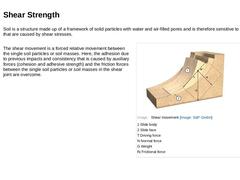
|

Soil is a structure made up of a framework of solid particles with water and air-filled pores and is therefore sensitive to shear loads that are caused by shear stresses. The shear movement is a forced relative movement between the single soil particles or soil masses. Here, the adhesion due to previous impacts and consistency that is caused by auxiliary forces (cohesion and adhesive strength) and the friction forces between the single soil particles … |
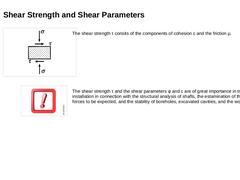
|

(Image: Soil element under shear loading [Schmi96]) The shear strength τ consits of the components of cohesion c and the friction μ. The shear strength τ and the shear parameters φ and c are of great importance in trenchless installation in connection with the structural analysis of shafts, the estamination of the jacking forces to be expected, and the stability of boreholes, excavated cavities, and the working face. |
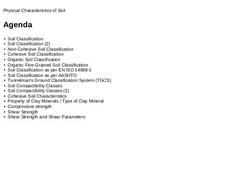
|

|

|

|